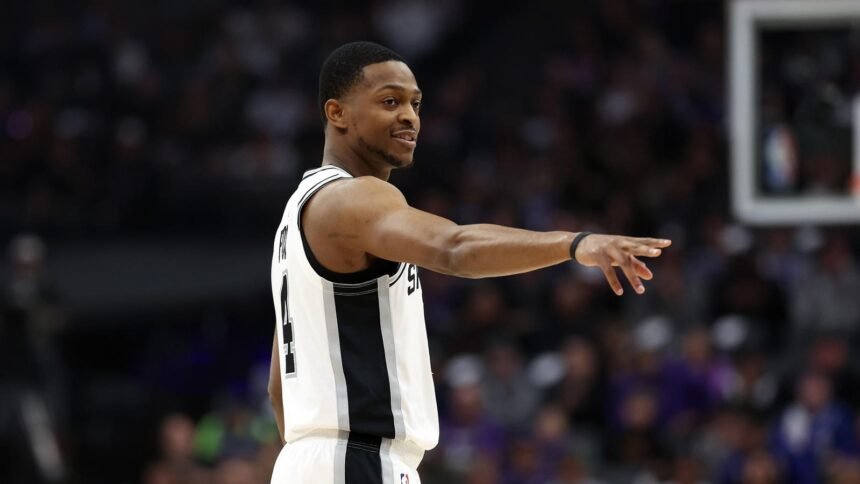SACRAMENTO, CALIFORNIA – MARCH 07: De’Aaron Fox #4 of the San Antonio Spurs points back towards the Sacramento Kings’ bench before his first game back in Sacramento after being traded from the Sacramento Kings at Golden 1 Center on March 07, 2025 in Sacramento, California. NOTE TO USER: User expressly acknowledges and agrees that, by downloading and/or using this photograph, user is consenting to the terms and conditions of the Getty Images License Agreement. (Photo by Ezra Shaw/Getty Images)
Getty Images
On Monday, it was announced that the San Antonio Spurs agreed to an extension that will keep their star starting point guard De’Aaron Fox under contract through the 2029-30 season.
The Spurs acquired Fox in a blockbuster three-team trade involving the Sacramento Kings and Chicago Bulls this past trade deadline. In 17 games with San Antonio (before being sidelined with a season-ending thumb surgery), Fox averaged 19.7 PPG, 6.8 APG, 4.3 RPG, and 1.5 SPG on 53.7% true shooting.
Considering the Spurs invested a good deal of draft capital to pair him with their franchise big man, they are probably happy to have gotten this deal done. However, I’m not super sure they should be thrilled by how this turned out.
The San Antonio Spurs Should Not Have Signed De’Aaron Fox To A Max Contract Extension
I want to make one thing clear. I think Fox is an outstanding player, and on a personal level, I am always happy to see an athlete be rewarded for all their hard work. But at the end of the day, all NBA teams are bound by a salary cap and a finite number of resources. Therefore, it is of the utmost importance to ensure that each player receives payment as close to their actual production value as possible. And in this instance, I think the Spurs failed to do that, thereby limiting their financial flexibility moving forward.
As many of my readers are aware, I deploy a method for estimating player production value that is loosely based on the one used by Seth Partnow in his book, “The Midrange Theory.” To learn more about it, check out this article here, but the general gist of it is that you multiply a player’s production (measured by Dunks & Threes’ Estimated Wins metric) by the amount a win costs (next season, a win is worth roughly 3.8 million dollars) to get their overall production value.
Anyway, if Fox plays at the level he played at last year next season, he will be worth about 23.6 million dollars, which is 13.5 million dollars less than he is slated to make (and his extension doesn’t even kick in until 2026-27). In 2026-27, that type of production would be worth 24.8 million (nearly half of what he’s expected to make).
Even if we granted Fox a cleaner bill of health (he only played 62 games last year), he would still be well behind the lofty figures he’s getting paid. If Fox played 75 games at the rate he played at this past season, his production value would still only be 30 million in 2026-27 (the Spurs are on the hook for 49.6 million).
Of course, injuries weren’t the only thing that hindered Fox in 2024-25. Fox clearly wanted out of Sacramento months before he was actually moved, and that likely hindered his performance. A more accurate way to conduct this type of analysis would be to assume he plays closer to his 2022-23 self (his lone All-Star appearance). Still, he doesn’t live up to his monster salary:
De’Aaron Fox Is A Flawed Star
This brings us to the “Flawed Star” concept I introduced nearly a year ago. Flawed stars are high usage players who sit in the league’s upper echelon, usually in the borderline All-Star/top 50 range, but for one reason or another, they have a weak point that keeps them from being a true top 15-20 player in the association.
For Fox, those variables are his jumper (career 33% 3-point shooter) and a good but not great passing profile relative to other primary ball handlers (83rd percentile Passer Rating, per Thinking Basketball).
Flawed stars are incredibly valuable, but max contracts aren’t really intended for them. So, when you sign a flawed star to a max contract, you create serious roster-building limitations for yourself in the future.
As we’ve learned with the Phoenix Suns, the three-star model no longer works. So, the Spurs are going to have to hope that Fox and Victor Wembanyama (who will also command a max contract when the time comes) have enough firepower to be the two stars they can build their next contender around.
The Spurs will need to compile the perfect amalgamation of role players to flank their star tandem. This is far from a futile operation, but it would certainly be a lot less difficult had they not given Fox a maximum extension.











